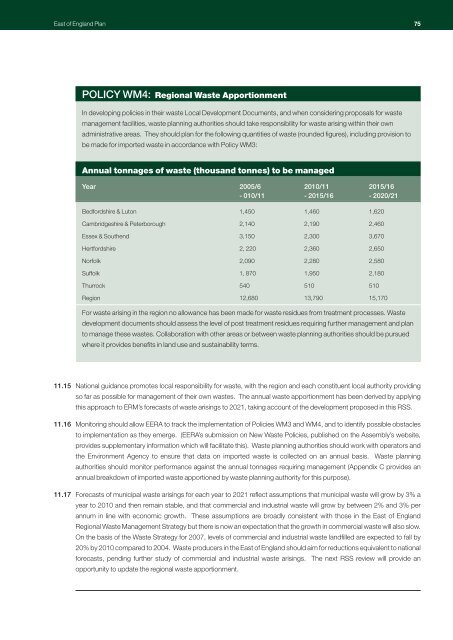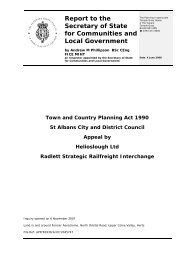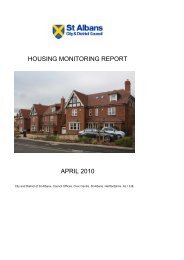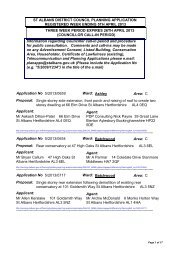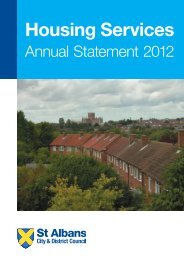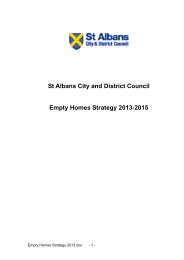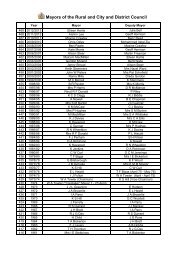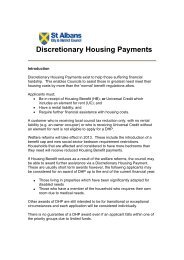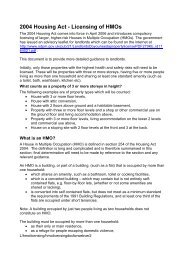RSS East Of England Plan - Broads Authority
RSS East Of England Plan - Broads Authority
RSS East Of England Plan - Broads Authority
Create successful ePaper yourself
Turn your PDF publications into a flip-book with our unique Google optimized e-Paper software.
<strong>East</strong> of <strong>England</strong> <strong>Plan</strong> 75<br />
POLICY WM4: Regional Waste Apportionment<br />
In developing policies in their waste Local Development Documents, and when considering proposals for waste<br />
management facilities, waste planning authorities should take responsibility for waste arising within their own<br />
administrative areas. They should plan for the following quantities of waste (rounded figures), including provision to<br />
be made for imported waste in accordance with Policy WM3:<br />
Annual tonnages of waste (thousand tonnes) to be managed<br />
Year 2005/6 2010/11 2015/16<br />
- 010/11 - 2015/16 - 2020/21<br />
Bedfordshire & Luton 1,450 1,460 1,620<br />
Cambridgeshire & Peterborough 2,140 2,190 2,460<br />
Essex & Southend 3,150 2,300 3,670<br />
Hertfordshire 2, 220 2,360 2,650<br />
Norfolk 2,090 2,280 2,580<br />
Suffolk 1, 870 1,950 2,180<br />
Thurrock 540 510 510<br />
Region 12,680 13,790 15,170<br />
For waste arising in the region no allowance has been made for waste residues from treatment processes. Waste<br />
development documents should assess the level of post treatment residues requiring further management and plan<br />
to manage these wastes. Collaboration with other areas or between waste planning authorities should be pursued<br />
where it provides benefits in land use and sustainability terms.<br />
11.15 National guidance promotes local responsibility for waste, with the region and each constituent local authority providing<br />
so far as possible for management of their own wastes. The annual waste apportionment has been derived by applying<br />
this approach to ERM’s forecasts of waste arisings to 2021, taking account of the development proposed in this <strong>RSS</strong>.<br />
11.16 Monitoring should allow EERA to track the implementation of Policies WM3 and WM4, and to identify possible obstacles<br />
to implementation as they emerge. (EERA’s submission on New Waste Policies, published on the Assembly’s website,<br />
provides supplementary information which will facilitate this). Waste planning authorities should work with operators and<br />
the Environment Agency to ensure that data on imported waste is collected on an annual basis. Waste planning<br />
authorities should monitor performance against the annual tonnages requiring management (Appendix C provides an<br />
annual breakdown of imported waste apportioned by waste planning authority for this purpose).<br />
11.17 Forecasts of municipal waste arisings for each year to 2021 reflect assumptions that municipal waste will grow by 3% a<br />
year to 2010 and then remain stable, and that commercial and industrial waste will grow by between 2% and 3% per<br />
annum in line with economic growth. These assumptions are broadly consistent with those in the <strong>East</strong> of <strong>England</strong><br />
Regional Waste Management Strategy but there is now an expectation that the growth in commercial waste will also slow.<br />
On the basis of the Waste Strategy for 2007, levels of commercial and industrial waste landfilled are expected to fall by<br />
20% by 2010 compared to 2004. Waste producers in the <strong>East</strong> of <strong>England</strong> should aim for reductions equivalent to national<br />
forecasts, pending further study of commercial and industrial waste arisings. The next <strong>RSS</strong> review will provide an<br />
opportunity to update the regional waste apportionment.


